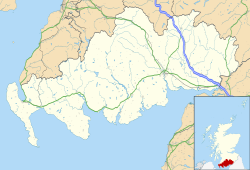Construction
The tower was built between 1494 and 1504 for Mariota Carson (or Acarsane) and her husband, Robert Gordon, within the Glenskyreburn estate that had been gifted to them by her father, John Carson. Gordon, heir to the Lochinvar estate, took on the designation "of Rusco" after its completion, and is sometimes referred to by his wife's surname in records. He was brought before the Lords of Council in 1501 or 1502, charged with the destruction of a house on Crown lands within the barony of Kirkandrews in order to remove timber and slates, possibly to be used for the construction of Rusco Tower; he claimed that the house belonged to him, but was unable to prove it, and was ordered to pay 1,000 merks in damages.
16th century
Gordon was forced to leave Rusco soon after it had been constructed. With his brother Alexander, he was implicated in the murder of John Dunbar of Mochrum around 1503, and while his brother fled the country, Gordon was put to the horn, a form of punishment similar to outlawry, and his possessions were confiscated; his estate was let by the crown to a neighbour. In 1507, while still under the horn, Gordon was given permission to travel to France, and in 1511 he was given a pardon for his part in the crime, and allowed to return to Scotland and take up his estate once more. By 1516, he had been knighted.
Rusco Tower was used to incarcerate a number of people in the 16th century. Gordon seized and imprisoned Janet Porter, an heiress who had recently married John McCulloch, a lesser member of the Cardoness McCulloch family. Gordon attempted to force her to sign over her inheritance, the Blacket estate, to him instead of her new husband, and McCulloch, who was not powerful enough to recapture his wife by force, applied to the courts. Gordon did not appear at the hearing, but in his absence the court ordered him to return Porter to her husband. It is not clear whether the order was obeyed, but records show that the Gordon family came to own the Blacket estate shortly afterwards.
Gordon spent several years in litigation with the Agnews of Lochnaw, who were related to him by marriage. In 1523 he sought to bring the legal dispute to an end by abducting Andrew Agnew, the heir of Lochnaw and his own grandson, and imprisoning him at Rusco. When the boy's uncle, Matthew Agnew, demanded that he be returned within three days, Gordon claimed that he had been placed in a school in Dumfries. The records do not show how this affair was concluded.
Rusco Castle, a Tale of the Olden Time
But lo! a little ruined tower,
Erected by forgotten hands,
Though once the abode of pride and power,
That by the river's margin stands—
Of old the Lords of Lochinvar
Here dwelt in peace, but armed for war;
And Rusco Castle could declare
That valiant chief and lady fair
Had often wooed and wedded there.
Upon the eastern bank of Fleet,
Castramont smiles—a hamlet sweet
Just fronting Rusco Tower,
Of peace and war two emblems meet—
None fairer than the first we meet,
The other seems a dark retreat
Where savage passions lower.
Sources:
Robert Gordon died in 1524, and within a year his wife Mariota Carson married Thomas Maclellan of Bombie. Since she owned Rusco Tower and its lands in her own right following the death of her husband, there would have been nothing to prevent her from leaving them to her new husband's family upon her death; her eldest son, James Gordon of Lochinvar, was so concerned that this might happen that he seized Rusco, where his mother was still living, and had her transported to the Borders and imprisoned. Her husband appealed to the courts, but before the case was concluded Maclellan was killed, in broad daylight, by Gordon and his retinue on the High Street in Edinburgh.
Later history
The later history of the tower was less turbulent. It was of minor importance to the Gordons once they had taken possession of Lochinvar, and was mostly used as accommodation for minor family members. It was sold in the 17th century, around which time a two-storey extension was added to the north side. [1] It was described in the poem "Rusco Castle, a Tale of the Olden Time" published in 1841 by Dugald Williamson of Tongland.
The tower was lived in until the late 19th or early 20th century, but was abandoned and allowed to fall into ruin between the First and Second World Wars.
In 1971, Rusco Tower was designated a Category A listed building. [1] The following year, it was purchased by Graham Carson, a Scottish businessman, who employed the architect W. Murray Jack to restore it to an inhabitable condition. The work was completed in 1979, and Carson moved into the tower with his family. Carson had a great-grandfather who was born in Wigtonshire, close to Rusco, and he attempted to find any connection between his family and the Carsons who had originally built the tower, but was never able to do so. He lived in the tower until 2006, when he moved out and his son, Ian, took up residence; as of 2018, Ian Carson was still living at Rusco Tower. [24]





